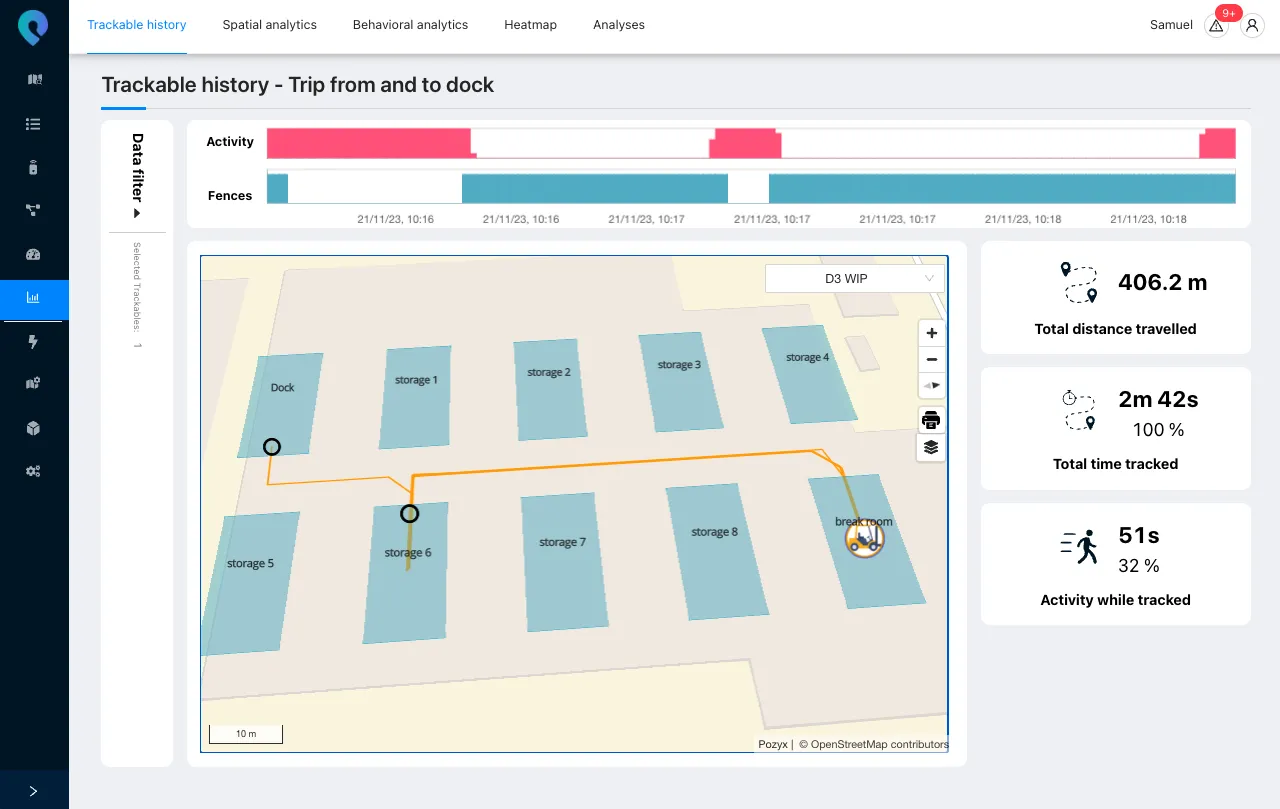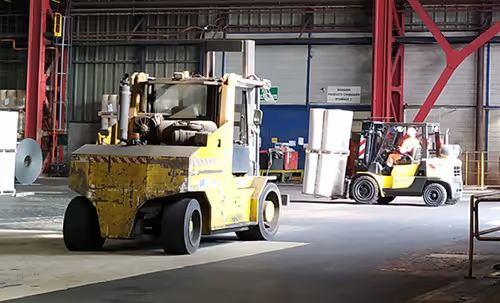Getting started with Indoor Tracking and Positioning
Understanding Indoor Tracking
Indoor tracking accurately locates and monitors the movement of objects or individuals within buildings. Unlike outdoor GPS, indoor localization faces challenges in achieving accuracy due to signal reflections and diffractions caused by complex indoor environments. GPS satellite signals struggle to penetrate buildings reliably, necessitating the deployment of alternative positioning systems and technologies for effective indoor localization. These indoor positioning systems provide real-time location data and are widely utilized across various industries, including manufacturing, warehousing, healthcare, and agriculture.
Example of Indoor Tracking in a Manufacturing facility
Indoor Tracking Technologies
Overview of Indoor Positioning Systems
While GPS is widely recognized for outdoor tracking, various technologies are available for indoor positioning. These include radio-based, optical, acoustic, and magnetic solutions, each tailored to specific use cases. Among these, radio-based solutions like Bluetooth positioning and ultra-wideband (UWB) have emerged as top choices for indoor tracking. Bluetooth positioning is anticipated to see over 107 million Bluetooth asset tracking devices shipped in 2024 due to its low cost and long battery life. In contrast, UWB stands out as the new golden standard for indoor positioning, offering precision, reliability, and scalability even in challenging conditions. These indoor location technologies cater to specific use cases such as asset tracking, navigation, and personnel monitoring.

Comparison overview of Indoor Positioning Technologies
Radio-Based Solutions
Bluetooth Low Energy (BLE): Bluetooth indoor positioning is a popular choice for indoor environments due to its affordability and efficient battery life. BLE technology is suitable for tracking assets, monitoring personnel, and facilitating indoor navigation. Its low cost makes it an attractive option for large-scale deployments in commercial and industrial environments.
Ultra-Wideband (UWB): UWB tracking technology offers superior positioning accuracy, making it ideal for applications requiring high precision. UWB systems are highly reliable and can operate effectively in complex environments with significant signal interference. This technology is scalable and is typically utilized in manufacturing, warehousing and healthcare.
Camera, Acoustic, and Magnetic Solutions
Acoustic Systems: Acoustic signals are used to pinpoint locations within indoor spaces. These systems can be highly accurate but may face challenges in noisy environments where sound interference is prevalent.
Magnetic Systems: Geomagnetic positioning systems use magnetic fields to locate objects. This offers very limited accuracy, but has the main advantage that it doesn't require any infrastructure.
Camera Systems: These systems use cameras and AI to detect object in view. Camera Tracking Systems can be low-cost but offer limited reliability as the AI must be trained on the objects to track.
Compare Location Tracking TechnologiesThe Pozyx Approach
Multi-Technology Integration
At Pozyx, we recognize that there is no one-size-fits-all technology for indoor positioning. Therefore, our Indoor Location Tracking System integrates both UWB and Bluetooth positioning to provide a versatile and reliable solution. This hybrid approach ensures dependable, adaptable, and cost-effective indoor location tracking across diverse settings.
Benefits of Pozyx's Indoor Positioning System
Pozyx's Indoor Positioning System leverages advanced indoor positioning technologies to deliver high accuracy and reliability. By combining UWB and Bluetooth, a single infrastructure can be used for a large variety of location trackers and provides valuable location data for various applications. This approach reduces total-cost of ownership, increases the potential applications, and meets the needs of modern industrial environments.



Typical 'assets' to track with an indoor positioning system
Infrastructure Requirements for Indoor Positioning
Essential Infrastructure Setup
Regardless of the chosen technology, most indoor tracking systems require the installation of dedicated infrastructure. Some systems can rely on existing infrastructure such as WiFi access points, but this typically results in limited accuracy or unreliable performance. The required density of the infrastructure will depend on the technology chosen and the complexity of the environment. Typically a density of 1 every 200 square meters is recommended for optimal performance.
Benefits of Dedicated Infrastructure
Cost-Effectiveness and Performance
Although the initial setup of a new network infrastructure might seem like a drawback, the benefits are invaluable. Establishing this infrastructure eliminates the need to rely on or pay for a cellular network, which is essential for GPS trackers to transmit location data to the cloud. This makes indoor location systems more cost-effective on a larger scale and provides more frequent updates on positions compared to traditional GPS tracking systems. With some indoor positioning trackers priced as low as $10, deploying them at scale becomes not only feasible but also highly cost-efficient.
Future-Proofing Your Operations
Investing in a robust indoor positioning infrastructure future-proofs your operations, allowing for scalability and adaptability. As your business grows, the infrastructure can support additional devices and expand coverage areas, ensuring continuous and reliable location tracking. This adaptability is essential for businesses looking to integrate new technologies and maintain competitive advantage in the rapidly evolving landscape of indoor positioning systems.
Indoor Tracking Software Solutions
Importance of Choosing the Right Software
Choosing the most suitable indoor tracking system and technology for your specific needs is crucial. Equally significant is selecting the right software to effectively utilize indoor positioning.
In the past, companies typically integrated their indoor tracking systems into their ERP or WMS systems to begin utilizing them. While this integration can still be highly beneficial, solely relying on it to leverage an indoor location system limits the potential or may result in high integration and development costs.
Key Capabilities of Location Tracking Software
Essential Features
When selecting a location tracking software platform, consider the following key capabilities:
- Search and find: Quickly locate assets and personnel within indoor environments.
- Asset management: Efficiently manage inventory and equipment.
- Geofencing: Define virtual boundaries and receive alerts when these boundaries are crossed.
- Location-Based Automation: Automate processes based on real-time location data.
- Location Analytics and Insights: Gain valuable data and insights to optimize operations.
- Open APIs: Integrate easily with other systems using open APIs such as the Omlox Hub API.
Addressing Security and Privacy Concerns
These tools can help address security and privacy concerns, especially when tracking individuals. Secure applications can anonymize employee locations, provide audit trails, and ensure compliance with security and privacy regulations. This is crucial for maintaining trust and adhering to legal requirements.
Learn more about the Pozyx PlatformCase Studies of Indoor Tracking
Selecting the Right Partner
Importance of Choosing the Right Partner
Selecting the right indoor tracking solution is crucial, but equally important is choosing the right partner. Understanding how indoor positioning systems work is essential for ensuring effective operation within buildings. Successfully executing an indoor positioning project requires a diverse set of skills. Mistakes such as using an incorrect floorplan, poor installation of infrastructure, or selecting the wrong tags can mean the difference between success and failure. Therefore, partnering with an experienced provider is vital.
Pozyx: Your Trusted Partner
With a decade of expertise in indoor positioning solutions, Pozyx is your trusted partner. Our team of customer success specialists ensures the successful completion of any project. Our award-winning solutions have been widely adopted across diverse industries in Europe and America. Moreover, our ISO27001 certification underscores our unwavering commitment to privacy and security, making us a reliable choice for your indoor positioning needs.
Advantages of the Pozyx Indoor Positioning System
POZYX INDOOR POSITIONING
- Best-in-Class Performance and Scalability: Our RTLS offers top-tier positioning accuracy and scalability, making it suitable for a variety of applications.
- Multi-Technology Support: The positioning system supports both BLE and UWB tags and sensors, providing flexibility and compatibility with various devices.
- Minimal Infrastructure Requirements: With long-range anchors and daisy-chaining capability, our solution requires limited infrastructure and cabling.
- Comprehensive Software Platform: The Pozyx location software platform maximizes the capabilities of your tracking system, offering robust features for asset tracking, geofencing, and more.
- Open API's: The system allows for easy integration with your ERP, WMS or other system.

in action








